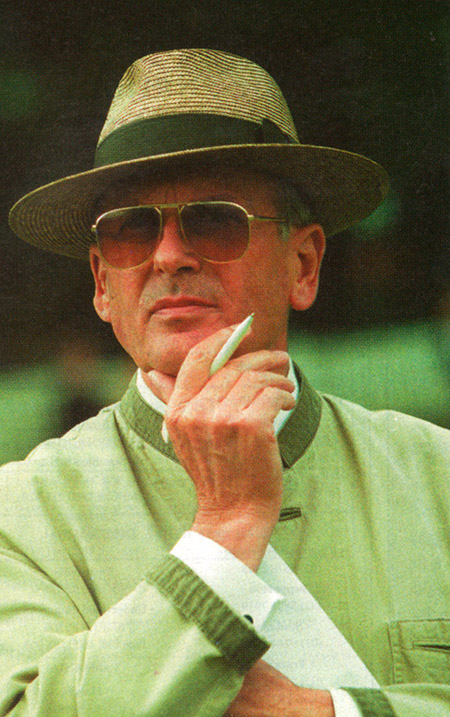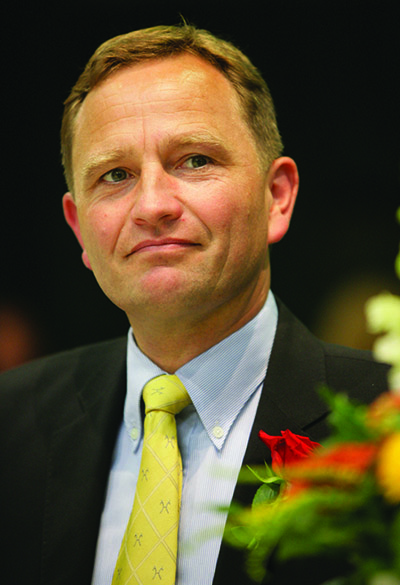Dr Gerd Lehmann was for 30 years – from 1966 until 1995 – the head of the Westfalien State Stud and is the man credited with turning a basically agricultural group of horses into the modern sport horse type. But Dr Lehmann is not happy with the direction of modern breeding, in particular the breeding policies of the Hannoverian Stud Book, from which the modern Westfalien drew so much of its inspiration – and blood.
In this interview, conducted with the help of Britta Züngel of Die Hannoveraner, Dr Lehmann calls for a return to the older aim of breeding an all-round sporthorse.
“You should take care in a big breeding population that the dressage stallions can still do some small showjumps, and that the jumping stallions still have a high rideability. If you are breeding in a certain direction, there is always the danger that the offspring go too far in one direction, and you end up with jumping stallions that are not rideable. The changes in the philosophy of showjumping course building has helped make the showjumping horse more rideable, in former times, the horse just had to jump with power, now there are more technical problems. People used to think that a showjumping horse had to have a big ugly nose, little eyes, a dumb looking horse – but this was even the breeding aim of some people, they thought a really tough looking horse, like Roman, would jump higher.”
“I didn’t want Roman, he was too big with a big head, but he was a brilliant showjumper, but I tried to breed something else.”
But does the dressage horse need jumping talent – or as has been argued, is there a negative correlation between jumping talent and dressage ability?
“I think that the negative correlation between the trot and the ability to showjump may hold true for this Hannoverian population of horses from which it was calculated, but it is not God given – it is just a result of these calculations from this group of horses. For example, Milton was a beautiful horse, he had very good basic gaits – so the negative correlation may work as a statistic for a whole population, but does not apply to the individual horse. Or look at Ahlerich, Paul Schockemöhle said he would have been a very good showjumper…”
But not perhaps, Rembrandt or Ganimedes?
“Ganimedes no, but Rembrandt he was a good jumper – and Ganimedes could have competed at medium level jumping with no problems. The most important aim in Warmblood breeding is the elasticity and the balance of the movement, and the conformation of the horse. The horse must always be in self-carriage, we aim to breed a balanced horse.”
Isn’t the pressure of the market, where the higher prices are being paid for horses of dressage breeding, pushing the breeders into dressage specialisation, irrespective of the policies of the Verband?
“You cannot define what a showjumping pedigree is – look at ET. The breeders are aiming to produce a eally beautiful looking horse that they can sell as early as possible. So often people believe that these sorts of horses cannot jump. Take Stakkato, his father is Spartan, but the mare is by Pygmalion is a Trakehner stallion not known for his jumping.”
Do you think the Hannoverian studbook is in danger of losing certain important bloodlines because of the concentration with over fifty- percent of mares bred to Weltmeyer, Rubinstein, Donnerhall, or their sons?
“Yes, we have lost the D line – not with Donnerhall but the Duellant influence which was responsible for Dux of Dr Klimke, and Doublette of Rosemarie Springer and Willi Schultheis. These were dressage specialists, yet we lost that Duellant bloodline. The mother of Grande was by Duellant. With Grande you would say he is by a showjumper out of a dressage mother line, and yet he was a genius as a stallion.”
But Dr Lehmann you yourself are talking about ‘dressage lines’ and ‘jumping lines’ and applying those terms to horses bred thirty, forty years ago – yet we often think this way of describing horses as dressage or jumping bred is a modern tendency?
“Of course breeders talk about dressage lines and jumping blood, but you shouldn’t do it. Look at Pilot, with a lot of dressage blood, like Graphit, yet Pilot was one of the best ever showjumping sires and all his offspring had rideability. From the great jumping line of Precipitation, through Furioso II we have Florestan (below) who produces horses of high rideability for dressage and showjumping. It is most important that any stallion should be able to jump small jumps. The freejumping is a qualification for the stallion licensing, and the stallions that do not show any jumping ability should not be licensed.”
Is it ever likely to happen that this process will be reversed, and that the Hannoverian Verband will look to licensing stallions with both abilities?
“I would ask the licensing commission not to license stallions that cannot jump but if there was a really really spectacular stallion who could move, but not jump, then you can put him in a big population. You can do that once or twice a year, with a really big population and a really spectacular stallion. We present the stallions on hard ground at the licensing, and if the young stallion shows high elasticity and a really nice and flowing movement, then he can jump.”
At the international seminar at Verden many speakers were talking about either breeding for an international competition horse, or a horse for the leisure rider, that you could not do both at the same time. To prove this, we would have to find the full-brothers and sisters of the international stars which are difficult horses to ride. I don’t believe this – I think that if we try every time to breed international superstars, then we get one once every thousand if we are lucky, and the others if they are given to leisure riders will be nice easy horses to ride. Do you agree?
“You are right, top horses should be rideable for everyone. The breeders are absolutely wrong if they think they can sell all the rubbish to the leisure riders. It is really wrong to think that the horse that makes the housewife happy riding in the forest can’t breed high performance horses – the horse of the housewife must have really high rideability.”
“If you look at the pedigree of the international competition horses they are not always bred along the fashionable performance lines. For example, Gigolo (above), he is out of a half-Thoroughbred mare and by a stallion with no reputation, and from his type and his conformation, you would say he is nothing.”
Is it a danger for the future that the breeders no longer breed to the stallions of their local stallion station, but get chilled semen from the top stallions – will this prevent another radical outcross – like Grande – emerging?
“I agree, and one of the problems is that the breeders are changing, they are now often businessmen with no knowledge of horses. The people who really know something about breeding, then their chances are far better than in former times, because they are now the best of the best, and the others are really of a very low standard. There are two kinds of breeders: the mare owner – and the breeder, and there is a difference. One of the problems for the future is that the breeders are not using enough Thoroughbred blood, you must have Thoroughbred blood to have elasticity, and the Thoroughbred improves the ground covering quality of the trot, and the willingness to perform.”
Our interview had come to an end – but it is a debate that goes on and on….
This article first appeared in the March 2001 Horse Magazine
Werner Schade & Ludwig Christmann – Carrying on the Debate…
At the time I interviewed Dr Lehmann, I got the feeling that he was regarded by some as a bit old fashioned and out-of-touch in his views, most people at that time were enthralled with the idea of breeding concentrated dressage lines. In the ensuing six years, it would seem that the thinking is coming around to something like Dr Lehmann’s views. Interviewed in 2007, the newly appointed Director of the Hanoverian Verband, Werner Schade was obviously thinking hard about the dressage / jumping balance. My question was:
We see breeding is getting better, and we are talking about dressage and jumping lines – Hanover once again won the World Breeding Federation Dressage standings, yet only one of the horses in that winning dressage group – the Weltmeyer son, Warum Nicht – was bred along dressage lines, the others, like Elvis and Salinero, were bred to be jumpers…
“This is very interesting, I am not entirely sure about our dressage breeding. We have bred a kind of dressage horse that is very successful at the Bundeschampionate, in the three and four year old classes. They have spectacular movement, they look like trained and developed horses, but sometimes it is difficult for this kind of horse to go the whole way. It is sometimes easier for horses with average movement to make the journey to the highest level – they have a good attitude, they have a strong back, they have activity and the ability to carry their body – not pushing their body with the big movement just in front. If horses are trained properly, they will get big movement because they are able to carry their body, and they have an ability to collect – we have many examples of what we would think of as jumping blood, at the top levels of dressage.”
And Warum Nicht got a very low score of 6.8 at the Bundeschampionate…
“Yes! There is a kind of specialisation that we have in the breed that we don’t need. We are a little too specialised on the young horse classes. It should be our aim to find good horses with strong backs and good activity – activity that is quick enough behind. The buyers of young horses would like to see a mature horse at a young age, and it is very difficult to bring this together, it takes three or four years to make a mature horse, we have to take care.”
“The philosophy for the Hanoverian breed for the future must recognize a certain degree of specialisation, but we don’t want to lose the type and the movement. We need the jumping lines to come back into dressage breeding.”
“If you look at the jumping horses, we have some horses, like the French horses that are as far away from dressage horses as it is possible to get. They have no rideability and problems with the mouth. I am convinced that these are not the jumping horses that we need for the future.”
“We need good rideability, we need good movement. Okay, if the horse jumps, they do it in all shapes, but we are not breeding for the 20 elite riders who can ride with the ‘freaks’, we are breeding for thousands of riders: we need a horse with good rideability so it is fun to ride that horse. We must bring it together, the level of the rider and the ability of the horse. Even the jumping horses, they need a certain level of movement and rideability, and this is also an advantage for our dressage horses.”
Werner’s colleague, Dr Ludwig Christmann, also suggests a little jumping blood to produce dressage talent:
 “We have to specialise when we produce jumping horses. I don’t think we would be successful if we used Wenzel or Bolero in the jumping lines, that does not work, but I think we have to consider using some jumping blood to produce especially dressage horses for Grand Prix. Breeding horses to win the Bundeschampionate at the age of four is different from breeding Grand Prix dressage horses. When you look at many top Grand Prix horses they are not the ones that win as three and four year olds. Five and six year old classes have more of a correlation to later competition success.”
“We have to specialise when we produce jumping horses. I don’t think we would be successful if we used Wenzel or Bolero in the jumping lines, that does not work, but I think we have to consider using some jumping blood to produce especially dressage horses for Grand Prix. Breeding horses to win the Bundeschampionate at the age of four is different from breeding Grand Prix dressage horses. When you look at many top Grand Prix horses they are not the ones that win as three and four year olds. Five and six year old classes have more of a correlation to later competition success.”
“At the State Stud they brought in a stallion like Conteur, he is bred on classical Holsteiner jumping lines, by Contender and on the mother’s side he has the R line, and he is a very good dressage horse. It should be interesting to try and get some of this blood into our dressage horses. But the stallions to use for this have to be good in their dressage ability, you cannot use any jumping stallion.”
Conteur is by Contender out of Ofarim, by Rasputin (Ramiro / Ramzes AA) out of a mare by the Thoroughbred, Tin Rod xx, out of a Ramzes AA mare. Conteur was second at his performance test at Adelheidsdorf in 2001, with a score of 131.7, but won the dressage section on 149.25 and was 25th in the jumping on a score of 90.99.
“If you look at Drosselklang, he has been very successful in producing international jumping horses but he would be a pure jumping specialist as a stallion, better not to try dressage with his offspring. The same with some of the French horses, the idea is not so much to cross jumping over dressage, but use some of the versatile stallions that combine both qualities.”





I am an adult amateur and own a 2003 Conteur offspring that has shown he excels in both Dressage and jumping. I currently compete hiim in Prix St George dressage and Preliminary level Eventing. He has a 10 in rideabilty.
In dressage his acccomplishments include;
First level regional reserve champion
Second level regional Third place and national 5th place
Third level. regional Third Place
Fourth Level Regional Third Place, National 9th Place
Currently showing Prix St George’s and schooling I1
Eventing:
Beginner Novice: regional an National 1st Place
Novice; National 6th Place
Training: regional 1st Place, National 3rd Place
Currently schooling Preliminary Level – placed 2nd in our first Prelim event.